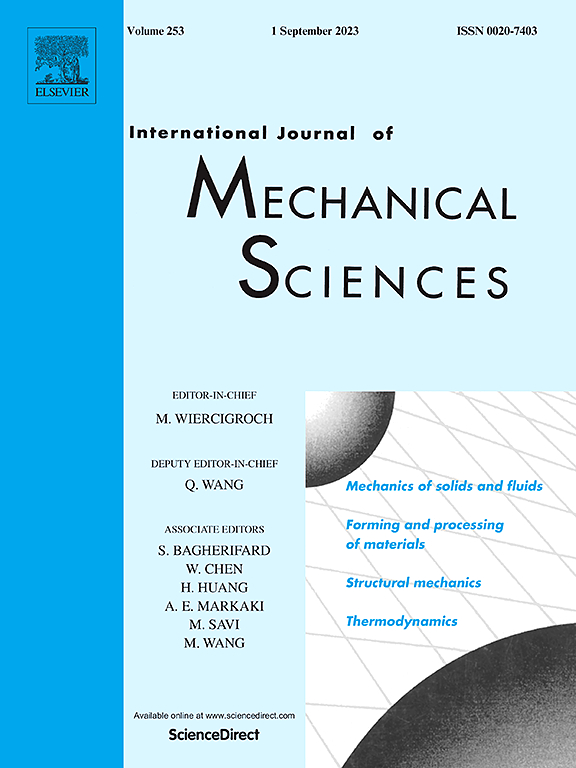A comprehensive investigation on the shear behavior of UHPFRCNC interface
IF 7.1
1区 工程技术
Q1 ENGINEERING, MECHANICAL
International Journal of Mechanical Sciences
Pub Date : 2025-04-25
DOI:10.1016/j.ijmecsci.2025.110309
引用次数: 0
Abstract
Ultra-high-performance fiber-reinforced concrete (UHPFRC)-normal concrete (NC) composite members reinforced with fiber-reinforced polymer (FRP) bars exhibit significant application potential in harsh environments due to their superior corrosion resistance. However, the UHPFRC![]() NC interface has been widely recognized as the weak link in these composite members, potentially compromising structural integrity. Consequently, this study comprehensively investigated the effects of FRP stirrups and concrete casting delay (CCD) on the interfacial shear behavior under direct shear mechanisms through push-off tests. Digital image correlation (DIC) and computed tomography (CT) techniques were employed to further elucidate the dowel action of FRP stirrups and the influence mechanism of CCD. The results demonstrated that both FRP stirrup configuration and CCD significantly affected the failure mode, push-off load-interface slip relationship, shear strength, ductility, and interface separation of single-sided shear specimens. The dowel action of FRP stirrups contributed to improving interface stress transfer. Reducing stirrup spacing and increasing stirrup diameter enhanced the separation confinement and shear capacity of the UHPFRC
NC interface has been widely recognized as the weak link in these composite members, potentially compromising structural integrity. Consequently, this study comprehensively investigated the effects of FRP stirrups and concrete casting delay (CCD) on the interfacial shear behavior under direct shear mechanisms through push-off tests. Digital image correlation (DIC) and computed tomography (CT) techniques were employed to further elucidate the dowel action of FRP stirrups and the influence mechanism of CCD. The results demonstrated that both FRP stirrup configuration and CCD significantly affected the failure mode, push-off load-interface slip relationship, shear strength, ductility, and interface separation of single-sided shear specimens. The dowel action of FRP stirrups contributed to improving interface stress transfer. Reducing stirrup spacing and increasing stirrup diameter enhanced the separation confinement and shear capacity of the UHPFRC![]() NC interface. As CCD increased, interfacial porosity progressively rose, becoming the dominant factor degrading interfacial shear performance. Conversely, reduced CCD facilitates steel fiber penetration across the casting interface, thereby enhancing interfacial shear strength and ductility. Leveraging the plastic upper limit theorem, a prediction model for UHPFRC
NC interface. As CCD increased, interfacial porosity progressively rose, becoming the dominant factor degrading interfacial shear performance. Conversely, reduced CCD facilitates steel fiber penetration across the casting interface, thereby enhancing interfacial shear strength and ductility. Leveraging the plastic upper limit theorem, a prediction model for UHPFRC![]() NC interface shear capacity incorporating the effects of FRP stirrup and CCD was proposed. Compared with existing models, the proposed model effectively predicted push-off test results with superior accuracy.
NC interface shear capacity incorporating the effects of FRP stirrup and CCD was proposed. Compared with existing models, the proposed model effectively predicted push-off test results with superior accuracy.

UHPFRCNC界面剪切性能综合研究
超高性能纤维增强混凝土(UHPFRC)-普通混凝土(NC)复合构件以纤维增强聚合物(FRP)钢筋增强,由于其优异的耐腐蚀性,在恶劣环境中具有重要的应用潜力。然而,UHPFRCNC界面已被广泛认为是这些复合材料构件中的薄弱环节,可能会影响结构的完整性。因此,本研究通过推离试验,全面研究了FRP筋和混凝土浇筑延迟(CCD)对直接剪切机制下界面剪切性能的影响。采用数字图像相关(DIC)和计算机断层扫描(CT)技术进一步阐明FRP箍筋的钉入作用和CCD的影响机理。结果表明,FRP箍筋配置和CCD对单面抗剪试件的破坏模式、推脱荷载-界面滑移关系、抗剪强度、延性和界面分离均有显著影响。FRP箍筋的钉入作用有助于改善界面应力传递。减小箍筋间距和增大箍筋直径可增强UHPFRCNC界面的分离约束和抗剪能力。随着CCD的增大,界面孔隙度逐渐增大,成为影响界面剪切性能的主要因素。相反,减少CCD有利于钢纤维穿过铸造界面,从而提高界面的抗剪强度和延性。利用塑性上限定理,建立了考虑FRP箍筋和CCD影响的UHPFRCNC界面抗剪承载力预测模型。与现有模型相比,该模型能有效地预测推离试验结果,精度更高。
本文章由计算机程序翻译,如有差异,请以英文原文为准。
求助全文
约1分钟内获得全文
求助全文
来源期刊

International Journal of Mechanical Sciences
工程技术-工程:机械
CiteScore
12.80
自引率
17.80%
发文量
769
审稿时长
19 days
期刊介绍:
The International Journal of Mechanical Sciences (IJMS) serves as a global platform for the publication and dissemination of original research that contributes to a deeper scientific understanding of the fundamental disciplines within mechanical, civil, and material engineering.
The primary focus of IJMS is to showcase innovative and ground-breaking work that utilizes analytical and computational modeling techniques, such as Finite Element Method (FEM), Boundary Element Method (BEM), and mesh-free methods, among others. These modeling methods are applied to diverse fields including rigid-body mechanics (e.g., dynamics, vibration, stability), structural mechanics, metal forming, advanced materials (e.g., metals, composites, cellular, smart) behavior and applications, impact mechanics, strain localization, and other nonlinear effects (e.g., large deflections, plasticity, fracture).
Additionally, IJMS covers the realms of fluid mechanics (both external and internal flows), tribology, thermodynamics, and materials processing. These subjects collectively form the core of the journal's content.
In summary, IJMS provides a prestigious platform for researchers to present their original contributions, shedding light on analytical and computational modeling methods in various areas of mechanical engineering, as well as exploring the behavior and application of advanced materials, fluid mechanics, thermodynamics, and materials processing.
 求助内容:
求助内容: 应助结果提醒方式:
应助结果提醒方式:


